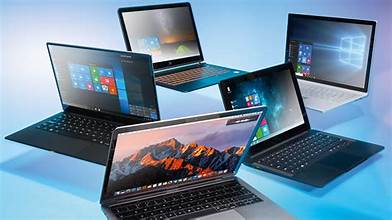
The laptop market is huge and diverse, with choices available to suit a wide range of needs and preferences.
Making the best laptop choice is of most importance for students for starting their academic careers. This extensive guide attempts to clarify the complexities of selecting the ideal laptop for students. Covering everything from portability to performance, financial factors to software compatibility. Let’s start our search for the ideal laptop companion for students now.
Portability is The Student’s Travel Companion: A top priority for students is frequent portability. They need a laptop that will easily travel with them to lectures, libraries, coffee shops, and study groups.
The key to making sure that students can transport their indispensable digital tool. Without putting too much strain on their backs or taking up too much space in their bags is a lightweight and small laptop.
When it comes to portability and usability, laptops with screens between 13 and 15 inches are perfect for students who are constantly on the go.
Battery life is the long-haul partner, as stated: Battery life becomes a crucial factor to take into account to avoid such situations.
Long-lasting laptops are needed by students for long classes or intense study sessions. Students can complete their academic tasks without looking for power outlets. If they have a laptop with a battery life of at least 8 to 10 hours.
Performance – Tailoring to Academic Demands : The effectiveness of a laptop is related to the student’s field of study and prerequisites.
A laptop with an up-to-date processor (like an Intel Core i5 or AMD Ryzen 5) and 8GB of RAM should be adequate for most coursework. It involves word processing, research, and web browsing.
To handle resource-intensive software applications. Students majoring in graphic design, engineering, or data analysis may need higher performance laptops with more RAM and content processors.
Storage Protecting Academic Assets:
A student’s laptop must have plenty of storage space. Research papers, e-books, multimedia presentations, and lecture notes can all fill up your storage.
Solid-state drives (SSDs) are the preferred option for students. Due to their faster data access speeds and durability, even though conventional hard disk drives (HDDs) offer ample storage capacity.
Most students find a balance between speed and storage on a laptop with at least 256GB of SSD storage.
Selecting the Appropriate Environment for Your Operating System: Personal preference and software needs are major factors when choosing an operating system. Windows, macOS, and Chrome OS are the three most common choices.
Students studying a variety of subjects. Can use Windows, which is renowned for its adaptability and compatibility with a wide range of software programs.
A favorite among creative professionals and design students is macOS. Which is only available on Apple’s MacBooks.
Students whose primary academic tasks involve web browsing. Document creation will find Chrome OS, which is found in Chromebooks, to be a lightweight and web-centric platform ideal.
Screen Size: Balancing Readability and Portability : The laptop’s screen size is crucial to a student’s comfort and productivity.
A popular choice for a display size is between 13 and 15 inches because it balances readability and portability.
Laptops with smaller screens are more portable and light-weight, while those with larger screens provide plenty of space for multitasking and reading.
When deciding on the ideal screen size for them, students should take their preferences and intended use into account.
Typing Comfort and Navigation Ease: For students who spend hours typing essays, research papers, and assignments. A comfortable and effective typing experience keyboards with spaced keys and good tactile feedback is obtained. A responsive and precise trackpad makes navigation easier and eliminates the need for additional mice or accessories.
Connectivity – A Bridge to Peripherals: Laptops that can connect to various peripherals and external displays are frequently needed for students. A laptop with a variety of ports, such as USB-A, USB-C, HDMI, and a headphone jack, provides flexibility when it comes to connecting to peripherals. Like external hard drives, printers, monitors, and headphones.
For students who may need to present projects or collaborate with classmates using various devices, connectivity options are essential.
Durability – Withstanding the Rigours of Student Life: Students can be demanding users, subjecting their laptops to a range of settings, from crammed lecture halls to busy coffee shops.
A laptop’s durability features, such as its tough design, spill-resistant keyboards, and shock-absorbing design elements, can help it withstand the demands of student life. Purchasing a sturdy laptop can save money over time by lowering the possibility of accidental damage.
Budget considerations: balancing financial realities:
Budget constraints frequently play a major role in a student’s laptop decision. Fortunately, laptops come in a variety of price points to suit different budgetary needs.For general academic tasks, more affordable options can still deliver dependable performance. While higher-end laptops offer more sophisticated features and specifications for users with larger budgets.
Students should consider their budgetary restrictions. And pick a laptop that meets their needs without breaking the bank.
Security Features – Protecting Academic Assets and Personal Data: In the digital age, security is crucial, especially for students who keep private information and sensitive academic materials on their laptops.
The safety features on a laptop can have a big impact on a student’s mind.
Many contemporary laptops are fitted with a number of security features intended to guard against data breaches and unauthorized access.
Biometric authentication, such as facial recognition or fingerprint readers, is an essential security feature.
With the aid of these features, a laptop can be opened and securely, allowing only those with the proper credentials to use it. In addition to biometrics, reliable password management and encryption tools are crucial for protecting data.
Full-disk encryption, such as Apple’s FileVault on macOS or BitLocker on Windows, ensures that even if the laptop ends up in the wrong hands, the data will remain inaccessible without the proper credentials.
Routine operating system : Another essential component of laptop security is routine operating system and software updates. These updates frequently come with security patches that fix flaws and guard against new dangers.
By identifying and removing malware, guarding against phishing attempts, and offering real-time protection, a reliable antivirus program further improves security.
In addition, modern laptops include privacy features. It includes physical camera shutters and microphone mute buttons to guard against unauthorised access to the webcam and microphone.
In addition, tools like “Find My Device” or “Find My Mac” assist students in tracking down their laptops in case of theft or loss and allow them to remotely lock or erase them.
Conclusion
Students need a strong set of security features to safeguard their academic private information
Students need a strong set of security features to safeguard their academic private information..
knowing that their digital world is safe and secure with these security features.
knowing that their digital world is safe and secure with these security features.



